#f1 History
Explore tagged Tumblr posts
Text










#posting this here cause it wasn't appreciated on tt#lewis hamilton#f1#formula 1#formula one#text post#f1 history#canadian gp 2007#rookies in f1#ky web weaves
259 notes
·
View notes
Text
not to talk exclusively about f1 but when they say history repeats itself they often forget the "until someone breaks the cycle" part of that & i think it's beautiful that history did in fact repeat itself with multi 21 and then brocedes and landoscar finally broke the cycle but for a moment can you imagine being seb watching f1 at home or lewis in the cooldown room and thinking about how you were once in your early twenties and you'd made a friend (or in lewis' case, grown up with a friend) and team orders & world championship-based hunger & a winner's mentality ruined it all and now you've either closed this chapter of yourself or you talk to that friend in interviews only? can you imagine seeing that in real time and remembering when you were in that position? can you imagine seeing something so beautiful become almost ruined because of a drive you both share, on a maiden win, no less? because i havent stopped thinking about it!
#f1#formula one#formula 1#landoscar#multi 21#brocedes#f1 history#hungarian grand prix#hungarian gp 2024#aera.talks
131 notes
·
View notes
Note
Ok but what is the GPDA strike sleepover? I’ve heard people speak about it and all the time I’m so confused lol 😂
So... this needs a bit of a history lesson ;-)
The GPDA is the association of the drivers.
It's in fact quite an old thing as it was created in 1961.
The strike sleepover is a reference to what happened at the South African GP in 1982.
Before the race, there was a strike led by the GPDA and in particular Niki Lauda and Didier Pironi. They were protesting against the new superlicence rules imposed by the FIA.
The protestation meant that most of the drivers retreated to a meeting room in their hotel and went on a strike until a compromise was reached with the FIA. (a few drivers didn't take part).
That's when the sleepover part happened with the drivers sleeping over mattresses provided by the hotel in the meeting room.


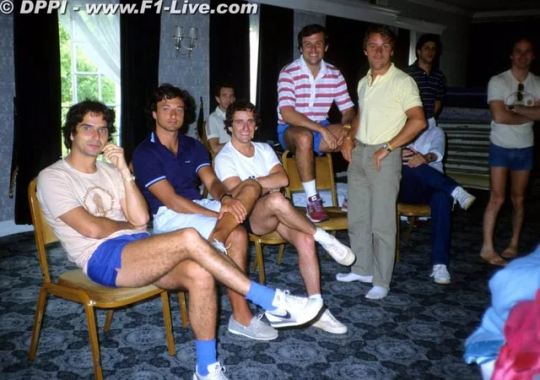

I need to mention the most famous quote linked to this: Patrick Tambay said, about Gilles Villeneuve and Alain Prost sharing a mattress: “If those two have kids after this tonight I might as well retire now.”"
In the end, an compromise was reached with the FIA but the GPDA was dismantled (and re-created in 1994 after the awful Imola weekend).
So, we are now imagining that the GPDA could organise a strike/sleepover again :-)
80 notes
·
View notes
Text
Women in Motorsports
Hello, this post is answering an ask about women in F1 and F1 related series. Great ask, let's go.
History:
So, unfortunately the history of women in motorsports is a combination of good and bad, but mostly bad. It's a story of limited opportunities, constant barriers, and many female racers being seen as the exception rather than the rule. F1 still to this day is a male-dominated sport, and even as recent as the 2010s many men in F1 deemed female racers to be a bad idea, or that women could not handle it. F1 legend Stirling Moss stated in 2013 or 2014 that "Women don't have mental strength for Formula 1 and would find it tiring" so this really is a culture in F1 that only in recent years has started to change.
But all throughout this history, women did fight for the right to race. Who were these women?
Maria Teresa de Filippis

The first woman to race in F1, she entered the sport in 1958. She competed in five Grand Prix's with Maserati and Behra-Porsche, and finished 10th in Spa. She possibly dealt with the worst of what the F1 world had to offer, as she was even banned from racing at some tracks, even being told at one point that "the only helmet a woman should wear is the one at the hairdresser's". While she only competed for a short time, she was a pioneer for women in motorsports.
Lella Lombardi
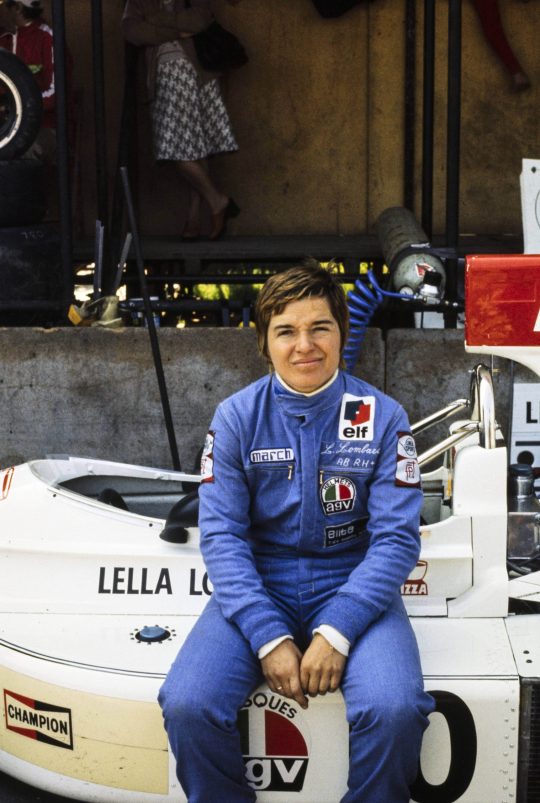
Lombardi is probably the most well known women in F1 history. She grew up racing, competing in karting at a young age and then rising up through other series, before being brought into F1 in 1974. She would race in F1 until 1976, and throughout her career would score points multiple times. Even when she left this series, she would still race for many years to come. While she is not the first woman in F1, she is perhaps the greatest trailblazer, as her performance and competitive spirit inspired many future female drivers and even garnered respect from many F1 legends.
Divina Galica

A famous British athlete (part of their olympic ski team) Galica also pursued a career in motorsports after performing well in a celebrity racing event. She competed in karting, then moved into F2 and F1. She raced in three Grand Prix's between 1976 and 1978, but unfortunately never qualified for the race.
Desiré Wilson

Known as one of the most accomplished female racers in the world, Wilson is the only woman to win an F1 race (as of right now), but this was in the non-championship series, Aurora AFX British F1 Series. Her only entry in the F1 championship series was the British GP, of which she did not qualify. Outside of F1, she had a thriving career, competing in Indycar events, winning the Monza 1000km, winning the Silverstone 6 Hours World Championship, winning the South African Formula Ford Championship, racing in Formula Pacific, the 24 Hrs at Le Mans, and more. A truly impressive racer and career.
Giovanna Amati
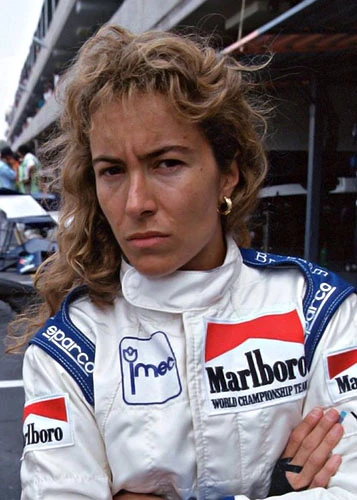
The most recent female F1 racer, Amati raced for Brabham in 1992. She had three entries, but did not qualify for a race. Outside of F1, she had a great career. She attended a motorsport academy from a young age, competing in her first series, Formula Abarth, in 1981. She then moved up to Formula 3 and Formula 3000 (scoring multiple win sin both series). She was able to secure a place in F1 after serving as the testing driver for Benetton, but her poor results meant she was fired quickly. After that, she went into other series like Monza 1000km, Sebring 12 hrs, the Ferrari Challenge, etc.
Development and Test Drivers:
Sarah Fisher: Indycar driver, tested for McLaren in 2002
Katherine Legge: Tested with Minardi in 2005
Susie Wolff: A Williams test and reserve driver in 2012, and the last woman to take part in a F1 race weekend as she drove in a FP in 2014. Currently the head of F1 Academy
María de Villota: Test driver for Marussia in 2012. Died from injuries in a crash.
Tatiana Calderón: An IndyCar driver who served as the development and test driver in 2017-218 for Sauber.
Jamie Chadwick: 2019 Williams signed her as a development driver until 2022.
Difficulties:
So, what are the difficulties or barriers that have held women back from competing. There are several, of course. In the early days it was general sexism and the belief that women could not handle racing that did it. The g-force of the car was deemed too aggressive, and even with technological advancements that have lowered g-force, this stereotype that women are too physically weak still lingers. The financial barrier is also a big one. Racing is extremely expensive, and securing a strong sponsorship is required to compete at the highest levels. But sponsors also tend to not go for female drivers as they view it more as a risk, because it is such a male-dominated sport. The general treatment female drivers have received over the years has also discouraged many from pursuing an F1 career. They are often treated to a lot more scrutiny and vitriol than there male counterparts, and on top of that are overly sexualized. I don't quite remember who, but one prominent F1 figure once stated that women should not compete because the second they put on a race suit, they are a sex object to be fantasized about. For young women this would be a massive deterrent to continuing their career. In general, the barriers women have dealt with are a mixture of all of these things put together. But what has the F1 world to try and alleviate these problems?
The W Series:

This series came about in 2019, and was a free-to-enter series for women intended to create a clear pathway and offer them more exposure. It was paused in 2022 after funding issues, and today is not in use. This did help launch the initiative to get more women into motorsports and gained the drivers who compete a lot more public attention.
The F1 Academy:

Launched in 2023, the F1 Academy is a series in the F4 category that is designed to provide support for female drivers, as well as higher access to sponsorships opportunities. Many modern drivers say that the biggest difficulty women in modern motorsports face is the lack of sponsorship opportunities, so the academy attempts to alleviate that. The Academy has their own races, but also trains the drivers on technical skills, media training, and physical conditioning. While this program is sometimes seen as controversial, mostly because people feel that it is condescending to put women in a separate category, this is mostly because people do not realize the purpose it. The goal is to help these young female drivers gain attention from sponsors so they can go on to afford to compete in the general categories, like F3, F2, and eventually F1. It is not intended as anything but a jumping off point and training center. Sponsors do not tend to go for young female racers because of the F1 gender bias, so the academy attempts to get rid of this, not replace the lower level series, and help the drivers gain more public attention.
The Future:
So, due to this growing momentum in recent years around women in motorsports, the question comes around; when will be see a woman in F1? I wish I had a good answer to this question. Most people believe that we could see a female F1 driver within the next decade, while others think it may take longer than that. As for how the academy helps, we haven't see the results quite yet. The drivers for the F1 Academy certainly have received much more attention that they would have due to the series, but they are still in the first generation so there are not clear results. The good news is that big name teams like Ferrari are starting to support young female drivers through their junior programs, and so perhaps we will see a female F1 driver sooner than we think. It still is a bit of an uphill battle, but I am optimistic about the future.
Alright, I hope I answered any questions about this topic. As a woman and a motorsport enthusiast, this a topic is very near and dear to my heart. Thank you again for the fantastic ask.
Cheers,
-B
72 notes
·
View notes
Text
Fernando Alonso All-Time Race Record
As voted by you, we start the break-down of the All-Time race records with forever rookie himself Fernando Alonso. With his first full year on the Grid being 2003 and taking 2019-2020 off to race in other series, he has completed a total of 20 SEASONS on the grid as a F1 driver. He has survived the addition of points, major regulation changes, three kinds of engines, multiple styles of cars/teams, and is getting ready to enter his fourth major change in 2026 with the rest of the grid.
He has achieved 2 World Drivers Championships with Renault (Alpine) and was runner-up 4 times (1 - McLaren, 3 - Ferrari). Throughout his first Decade on the grid he only finished outside the points 13 times and only DNF'd 29 times; whereas in his 2nd Decade he has been outside the points 39 times and DNF'd 42 times, almost all of which was gathered during his 2nd stint with McLaren from 2015-2018.

His potential 3rd and 4th WDC's would have been in 2010 and 2012 respectively while he was driving for Ferrari and going head-to-head with the original Red Bull G.O.A.T Sebastian Vettel. As in 2010 he missed out by only 4 points, due to a DNF in Malaysia because of an Engine Failure after 54 laps. Then again in 2012 he missed out by only 3 points with the two DNFs being Belgian and Japan GPs; in Belgium Romain Grosjean squished Lewis…which then caused Lewis to spear Sergio Perez…which then Sergio went airborne and landed on Fernando pushing him out, and in Japan Fernando took turn 1 to close to Kimi Raikkonen who then punctured Fernando's rear tyre and sent him into a spin.
After the 2014 season he went back to McLaren (after they failed him once I might add) in which he had his worse stint in his whole career. This made him decide to step away from F1 with his perception that "The races were predictable, the media is overly harsh, and the fan base is falling." In which he took two years and drove within WEC and Off-roading series before ultimately deciding to return to his original home of Renault in 2021.
Since he has become at peace and just loving to drive for as long as he can, all while knowing it won't last forever; so he is choosing peace and stability over fighting for championships 24/7….hence why he is okay taking time with Aston Martin and is not actively fighting to switch teams; maybe with 2026 bringing back smaller cars and Adrian Newey plus multiple heavy hitters up and down the grid joining Aston he can finally get his 3rd WDC and retire with a smile on his face.
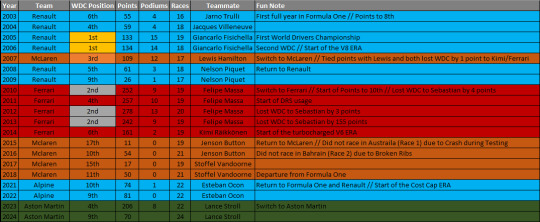
#f1#f1 analysis#data analytics#f1 history#f1 wdc#fernando alonso#reanult f1#alpine f1#mclaren f1#ferrari f1#aston martin f1#formula one#felipe massa#sebastian vettel#romain grosjean#kimi raikkonen#sergio perez#lewis hamilton#nelson piquet#jenson button#stoffel vandoorne#esteban ocon#lance stroll#jacques villeneuve#giancarlo fisichella
27 notes
·
View notes
Text
Everytime I do a history style post it does really well. So that being said, let me know who weird stories you’d love to learn more about, specific history, driver backstories, etc and I’ll start making them more regular! I’ll do basically anything F1 or F2
Some topics I’m already considering:
F2 controversies, the gpda’s history, young seb, young Lewis, Fernando’s big crash, the missing Monaco diamond, the strolls involvement in motorsports, teams that left the grid, the airstrikes a few years ago, red bull driver academy, the creation of Vegas gp, Juan Manuel correas backstory, etc
#f1#formula one#lando norris#max verstappen#charles leclerc#lewis hamilton#formula one facts#f1 history#gods#Pierre gasly#carlos sainz#vegas gp 2024#Red Bull academy#f2
21 notes
·
View notes
Text
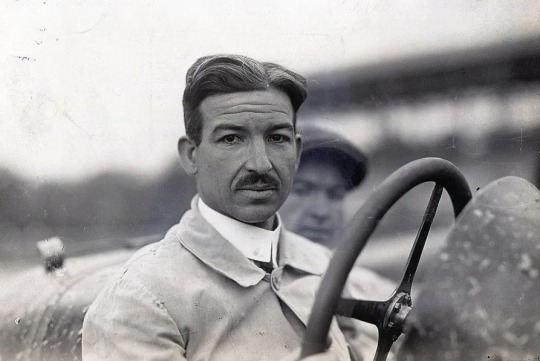
Alfieri Maserati | F1 History
19 notes
·
View notes
Text
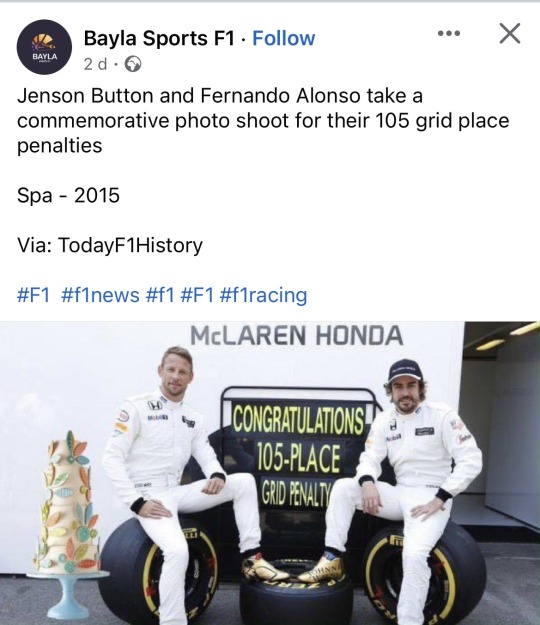
One our finest moments as a McLaren fan.
This ladies and gentleman is why McLaren fans have acted like it’s Christmas Day every time we have qualified on the front row or got a podium in recent years! This is where we came from. When we failed, we failed epically.
For the record they finished 13th and 14th of 16 finishers, a lap down!!!
58 notes
·
View notes
Text
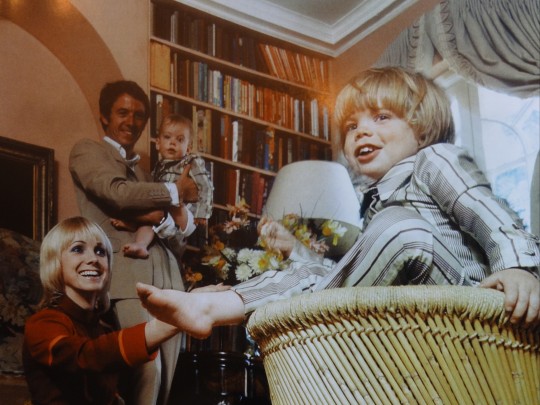
Piers Courage with his family
#awh they all looks so adorable#classic F1#formula one#f1 history#piers Courage#classic f1#f1#formula 1#vintage f1
14 notes
·
View notes
Text
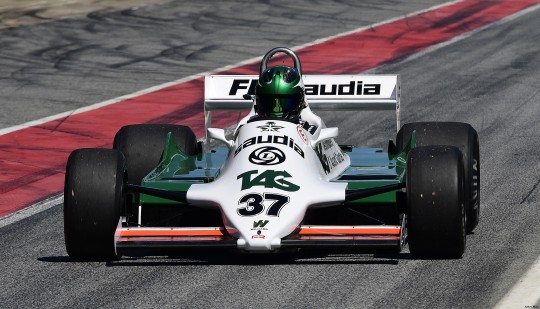
Williams FW07C
Image by Artes Max || Twitter
12 notes
·
View notes
Text
On This Day in F1: February 23
Present: Testing Day 3
History: 1958 Juan Manuel Fangio Kidnapped
February 23rd was the last day of testing and once more red flagged due to a drain cover. Instead of 2 sessions, there was one long session with drivers switching off halfway through.
With testing over, there’s only a few days until the first race of the year. The Bahrain Grand Prix will be on Saturday March 1st.
In 1958, February 23rd was not marked by the end of testing, but rather a kidnapping.
In 1957, President Batista of Cuba established the Cuban Grand Prix as a non-Formula One race. Despite it being a non-Formula One race, many F1 drivers did travel to Cuba for the race. The 1957 running had been won by Juan Manuel Fangio.
However, when Fangio returned to Cuba for the second running of the race, it was not as successful as his 1957 run. During practice, Fangio had set the fastest times and was the favorite to win. But on February 23rd - the day before the Grand Prix - Fangio was kidnapped by two men from Fidel Castro's 26th of July Movement.
The intention was that Fangio's kidnapping would force Batista to cancel the Cuban Grand Prix and embarrass Batista's government. Despite the kidnapping of Fangio - the 1957 F1 World Champion - Batista ordered that the race happen while the police searched for Fangio. To ensure the race happened, Batista set up:
Roadblocks at intersections
Guards for all airports - private and commercial
Guards for the other drivers
Fangio was handed to the Argentine embassy after the race was finished and Batista's inability to find Fangio's captors was a sign that he was losing his power.
In an interview with the New York Times, Fangio asserted that his kidnappers had treated him kindly.
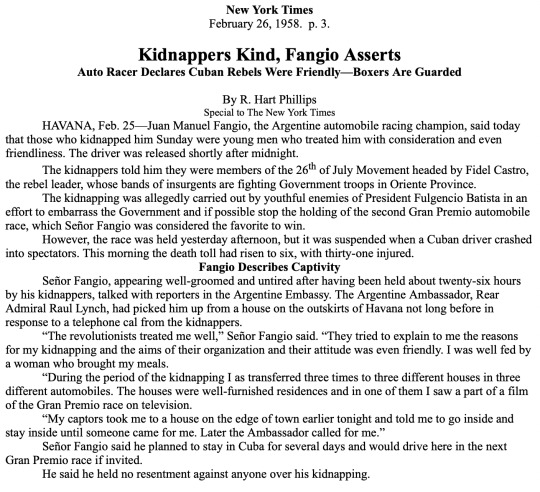
Instead of Fangio, Stirling Moss would go on to win the 1958 Cuban Grand Prix, but it remains a race marred by tragedy. Cuban driver, Armando Garcia Cifuentes was driving a Ferrari and was inexperienced. Six laps into the race, Cifuentes crashed into the crowd killing seven people and injuring 31 others.
____ Previous: Feb. 22 - 2012 Ross Brawn on Teams Leaving FOTA
Next: Feb. 29 - Bahrain Day 1
On This Day in F1 Masterlist
20 notes
·
View notes
Text
F1 Driver's Championship winners who switched teams right after they won it
This post was inspired by a question asked by @vro0m the other day. Although they were asking about drivers who left WCC winning teams, i thought drivers champions who ditched their teams would be interesting as well.
Juan Manuel Fangio, 1956->57; Ferrari->Maserati. (was known to drive for a different team after each of his championship wins up yo this point, but its important to note those times had to do with his teams leaving the sport. The only time it was his decision was 1956->57)
Alberto Ascari, 1953->1954; Ferrari->Lancia (Not paid enough, perhaps on the grounds that he was risking his life)
Denny Hulme, 1967->68; Brabham->McLaren (can't find a source on this one but he was extremely close to Bruce McLaren and had driven for him in other race series. To give an idea of why i think their closeness could have been a factor, he was considered a man of fewer words and emotions than Kimi Raikonen, but openly weeped at Bruces death in 1970 during a testing accident)
Jackie Stewart, 1969->70; Matra->Tyrell (this could be semantic. Matra International was a "privateer" team from 1968->69 which was actually a collab between Tyrell the man and the french company Matra. The name of Stewart's team changes from 69-70 because Tyrell the man prefered maintaining a working relationship with Ford whereas Matra was moving on to Chrysler. Wikipedia articles partially seem to think the Tyrell team is basically a continuation of the Matra International team the year prior since Tyrell the man was technically the team owner of each. Matra however enters a works team in 1970 that also ran one race in 1969 so its confusing. )
Jochen Rindt, Honorable mention; he died in the Italian GP practice in 1970. He had such a big lead he still won the championship in spite of his passing.
Nikki Lauda, 1977->78; Ferrari->Brabham (Nikki's huge accident that almost killed him in the 1976 season changed his outlook on racing in exceptionally poor weather conditions. As a result, he refused to race in the 1976 Japanese GP, and lost the championship to James Hunt in the process. Ferarri was pissed about this and it deteriorated his relationship with Ferrari severely for the 1977 season. After being treated so poorly (even in the driver lineup from his point of view) he decided to leave despite winning the championship. Its important to note however that he's believed to have won by consistency despite the car's outright slower pace, so he might have also had technical concerns)
Nelson Piquet, 1987->88; Williams->Lotus (in 86 and 87 Piquet was racing alongside Nigel Mansel in a WCC winning Williams. According to Piquet he had an agreement with team owner Frank Williams that he would be the number one driver for 86, an agreement he felt was neglected after Frank got in a car accident and left the team in the management of Mansel's race engineer. Specifically, he was upset that Mansel was not ordered to let him pass for the race win on two occasions that year, and had he been let through he would have been champion rather than Alain Prost. The relationship never recovered from that, but for some reason Piquet waited to leave. It is worth noting that he signed for Lotus before winning the 87 championship. Additionally Mansel finished first in more races than him that year but lost because of Piquet's podium consistency)
Alain Prost, 1989->1990; McLaren->Ferrari (ho boy. Long story partially short, Prost believed Honda (engine supplier) favored Senna, and therefore so did McLaren for the 1988-89 seasons, to the point of even giving Senna a better engine in the 1989 season. Supposedly for the 1988 season a Honda employee confirmed the suspicion while speaking to Prost in person, but promised he'd do his best to change that for 89. Prost did not believe this had occured, as he felt his car was underperforming Senna's in 89. His biggest piece of evidence was that while running a better straight-line-speed setup than Senna in Mexico, he still was not being able to pass Senna by engine power on the straight. For Honda's part, they had a major press event where they tried to explain technically why Senna's driving style suited the engine better, but the employee giving the interview kept referring to prost by his surname but not Senna, which is a sign of a stronger personal relationship in Japanese culture and was taken as a sign of bias)
Nigel Mansell, 1992->93; Williams->N/A (retired)
Michael Schumacher, 1995->96; Benneton->Ferrari (Schumacher's official statement is that he abandoned his contract with Benneton a year early due to "the teams damaging actions in 1994" to use wikipedias wording. The teams actions include: software shenanigans where the car was found to have the supposedly unused ability to correct bad manual starts, which would give the driver the ability to have perfect starts regardless of their affectiveness with the clutch; ignoring a black flag for a safety car overtake; and having a skidblock that was so worn down it suggested Benneton was ignoring aero regulations)
Damon Hill, 1996->97; Williams->Arrows (this one doesny count because it was outside of Hill's control, but it's really funny. Williams sacked him in favor of Heinz-Harald Frentzen, whom i have never heard of and apparently would only ever win 3 F1 races in his career. Hill chose Arrows not because they were the best team with an offer, but because they wanted to pay him the most. His career sucked after that)
Fernando Alonso, 2006->2007; Renault->McLaren (wikipedia straight up just doesnt explain this. A reddit thread gives a lot of uncited opinions as to why, but a significantly large number of their users cite that McLaren was seen as a consistently top team in this era while Renault was seen as volitale. With Alonso signing for 2007 as early as late 2005, heres some possible factors: Renault's bizzare lack of commitment to staying in the sport; McLaren winning more races in late 2005 than Renault; Renault's success was partially attributed to weird tire rules).
Jenson Button 2009->10; Brawn->McLaren (Brawn was bought out to become mercedes, but was left to its Brawn leadership to still run the team. Jenson won the championship because of dominance at the beginning that was cut short by not developing the car enough. He still won overall, but Jenson asked for a larger focus on in-season developement for the next year as a condition for staying. Ultimately, he was spoked off when he discovered mercedes didnt have enough sponsors for their plan yet)
Nico Rosberg, 2016->17; Mercedes->N/A (retired)
#f1#f1 history#nico rosberg#fernando alonso#michael shumacher#damon hill#alain prost#nelson piquet#niki lauda#jochen rindt#jackie stewart#denny hulme#alberto ascari#juan manuel fangio#motorsport#motorsport history#tw death
28 notes
·
View notes
Text
In Depth: Liberty Media Acquisition
Hello, this post is a response to an ask about what changed in F1 after Liberty Media took over. Great ask, let's dive in.
So in early 2017 the F1 world went through a massive change when it was announced that Liberty Media (LM), an American mass media company, would be taking over. This was an $8 billion acquisition, and they purchased it from Delta Topco, another US company, which was in large part owned by Bernie Ecclestone. The biggest management changes right away were that Ecclestone stepped aside as manager and Chase Carey became the new CEO. Also, Ross Brawn returned to F1 to manage the sporting and technical aspects.
But other than administration, what else changed in F1?
Business Strategy
So, one off the major things LM set out to do was really bring F1 into the digital age. Up until that point F1 had been rather slow to get involved with social media and streaming platforms, but LM knew that modern popularity would stem from there. So they started having a presence on Twitter, Instagram, YouTube, etc. They launched F1TV, a streaming service for all content. They created an app dedicated to news, updates, and tracking standings. All of this helped bring more attention into F1.
Another part of their new strategy was increased fan engagement. Previously the barrier between fan and paddock was much stronger. But LM introduced things like fan festivals, grid-walks, behind-the-scenes content, and other such fan-focused content. They wanted the sport to be extremely accessible to fans, as this is what the younger generation often expects. Nowadays fans can pay to be in the paddock even, or take a tour of a team's garage and see their car's. While the previous management sometimes had special events like this, LM took it to another level.
The final major business strategy that they changed was their sponsorship connections. They renegotiated a lot of the old deals and changed revenue sharing model to get the smaller teams a larger chunk of the sponsorship pie. The goal of this was to make F1 more competitive, as fans tend to not enjoy complete dominance very much. They also connected with some more modern and new sponsors, where previously F1 tended to stick with the old. This allowed them to reach a newer demographic.
Regulations
So, when LM took over they brought with them sweeping regulation changes, but of the major ones started to get introduced only recently in 2021. The biggest of this was the budget cap that was introduced for teams. This limited how much each team could spend per season, also in an efforts to level the playing field. One of the other major changes introduced in 2021 was the car design overhaul. The aerodynamics of an F1 car were changed significantly in order to make overtaking a little easier. As always, this was to make races more exciting.
Beyond those regulations, LM also altered how race weekends worked. They added sprint racing on certain weekend starting 2021, in an effort to make championships tighter and draw more public attention with faster and more eventful races. While the basics of the weekends stayed the same, tighter media scheduling was added in as well and they shifted some race times around to suit a more global audience.
Race Calendar
LM also altered the race calendar when they bought F1. As an American company, it was clear that their major goal was to expand F1 in the US. So US races were brought back, with Miami, Austin, and Vegas being added to the calendar. They also added a lot more races in previously untapped markets like Saudi Arabia and Qatar. While the push was mostly led by a wish for globalization, it also has to do with increasing revenue through hosting fees.
Environmental Concerns
One of the hottest topics in F1 is the environmental concerns that the constant racing creates. This led LM to set a goal to be carbon neutral by 2030. As of right now, they are still working on innovating more sustainable fuel, hybrid engine development, and reducing the sport's overall carbon footprint. This stems from a wish to align F1 with the rising trend of sustainability, making it more attractive to more sponsors and fans.
Audience
Of course you cannot mention the LM changes without mentioning the audience changes. Since 2017, F1 has exploded in popularity. efforts to raise global popularity have worked, and especially in the US F1 is becoming a popular sport. A lot of this stems from their increased presence globally, but a large chunk is from the amount of access LM has given fans. One of those major things was the Netflix docuseries Drive to Survive, which started its first season in 2018. While a bit of a controversial show, it gained an absolutely massive amount of attention, especially among younger American demographics, and led to F1 kind of explode in recent years.The previous demographic for F1 tended to lean more on the older side, to they really opened the doors when they gained this much younger audience.
Alright, so those are the major changes that occurred when Liberty Media took over. At the core F1 is still the same, but this acquisition definitely launched it into the modern age and is responsible for it's current popularity. I hope I answered any questions.
Cheers,
-B
22 notes
·
View notes
Text
🏎️ F1 Fans, this one's for you! 🏎️
Looking for a deeper dive into your favorite sport? Well, you're in the right place! I’m Andreas, an aspiring sports journalist on a mission to bring you closer to the world of Formula 1. 🚥
✨ FOLLOW ME FOR:
- F1 content and commentary
- A fresh perspective on the racing world from an up-and coming sports journalist
- A platform to share all your thoughts on all things F1
- Race highlights and driver spotlights
-A glimpse into my journey as I make my way into the world of motorsport journalism.
Join the community of F1 fans and follow me on socials as @chequeredandreas (find the links below) and let's dive into the world of F1 together! 🏁
5 notes
·
View notes
Note
Hello, I just saw an ask you sent abnerkrill about f1. I'm very new to the sport (I'm on s4 of Drive to Survive and have just begun following the current season), and doing some research into f1 history for a project I'm working on. Do you have any resources on the history of f1? And do you know where I can find the Senna documentary? No pressure to respond, of course, and thanks for sharing your insight in that ask.
Hell yeah I can help! DTS is docudrama which means it will make a storyline outta nothing, so you've probably been given a very warped view of the sport. Which isn't to say it isn't good fun! Its just not helpful to understanding the sport.
I've been into motorsport coming up on 4 years now and I've read/watched a bunch on the history of F1 and motorsport. I'll list some of that stuff here:
MY RECOMMENDATIONS:
One: Life On The Limit (documentary)
Free on youtube. Interviews tons of drivers. Got me into the sport. I mean it when i say it interviews a ton of old drivers/important people from multiple eras and paints a real picture of the danger of the sport. Fair warning: it contains footage of fatal crashes and if you find that upsetting I totally understand and won't blame you for skipping it
Lauda (Documentary)
Eveyone should know about Niki. I say this half-ironically. Hes my fav driver so I'm biased but his impact on the sport cannot be overstated. His story, from his championship to his horror crash and full body burns to his next two championships and his fight for driver safety is incredible. He was half of the pair that organized the famous driver strike! Whole grid locked themselves in a bedroom instead of driving to protest the lack of safety!
Rush (Movie)
Again Niki Lauda related, however this is THE motorsport movie. It's very accurate to the battle between James Hunt and Niki Lauda for the championship, along with their friendship. It's great and even non-motorsport enjoyers loved it.
Biographies/Auto-Biographies (Books)
Tons drivers have tons, some have multiple (like Senna or Schumacher) and you can get the more well known ones from the more well known drivers off Z-Lib or annasarchive pretty easy (use a vpn and go to r/piracy and navigate to their masterpost of piracy links. if you dont have a vpn dw they list a really solid free one) you should also be able to find a host for the senna doco through there. I would recommend reading about figures like Prost, Schumacher, Lauda, Hamilton obvs but also non-drivers in the sport like Ross Brawn and Sid Watkins.
Life on The Limit (Books)
Two books by Sid Watkins (doctor who made f1 safe) that were released in tandem with the doco I mentioned and go into great detail about his friendship with past drivers. Really funny at multiple points and then absolutely heartbreaking when it comes to the things he saw and lost during those days. Highly recommend.
My friend Laura who has been watching since infancy also recommends:
- "In general for freebie resources, overtakefans as a site has a Ton of resources and history archived"
- "and if you search for 'F1 season reviews YouTube' you will usually find the short season round ups they used to do that provide you with some basic history and that can be really good if you want to know more about certain eras but don't know where to start."
Silver War (documentary)
It's abt nico and lewis and their lifelong friendship into bitter toxic rivalry into. whatever the fuck it is now. is on youtube, (I personally haven't seen it.)
Grand Prix: The Killer Years (Book)
About the deadly years of F1, I believe. (I haven't read it.)
Enzo Ferrari: The Man and The Machine (Book)
from Laura: "even though it starts WAY WAY WAY before f1 and is probably too heavy for a newbie to handle it is a VERY detailed look at not just Ferrari but early Motorsport in Europe and how that eventually led to the creation of F1 and why Ferrari has always been a presence in it"
The book also touches briefly on fascism in the sport which I will be talking abt under the readmore because I do feel it's an important disclaimer.
So, I put this under a readmore cos it's a bit long. But the one last thing I wanna say is that I think it is important when looking at F1 both in the current day and it's history to discuss the grim realities about why Motorsport is so elitist, and how that has been ingrained since it's founding.
A big thing to know about F1 history is that is was founded by the wealthy, juuust pre (late 1920s) and then post WW2 (paused during the war). It was the wealthy of this era who could afford to buy and race motorcars. From there, it was only those wealthy who could fund and form those teams. It was a rich mans hobby. And unfortunately, more often than not, those very rich men had fascist ideals (which were very, very popular in England and Italy and Europe in general and up until WW2 which made it a more distasteful ideal, although enough people certainly persisted with these beliefs more quietly).
Nazis raced in it. Nazi sympathizers raced in it. Ferrari had to work for Mussolini and Mercedes had to work under Hitler making weapons during the war, some members of these companies more willingly than others. Hell, one of F1s most famous circuits it raced on is the Nurburgring. A massive stretch of track that was made on the orders of Hitler, next to a small town where the small Jewish population had been purged. It was built to show off German Engineering and with the hopes to show off to the rest of the West (they lost against the English in the inaugural race and threw a fucking fit abt it loser fucking nazis).
These echoes of facism and elitism do still exist in european motorsport to this day and, like fascist ideals, have expanded into other continents. I don't think I could name a Brazilian driver who doesn't support Jair Bolsonaro. The Piquets are personal friends with him, Nelson (4 time world champ, prolific racist) drives him around for political rallies. Emmerson Fittipaldi (another old champion, Brazilian) ran as an MP for the Italian fascist party. Bernie Ecclestone (owned the rights to f1 for a WHILE) believes in fucking insane conspiracy theories about Jewish people and described Putin, who he is friends with, as a "good man" on national television when questioned abt the invasion of Ukraine. Max Mosely, who was head of the FIA until the late 2000s, was a youth fascist who handed out handwritten leaflets on "racial inferiority". His parents wedding was attended by Hitler himself. He was the nephew of Oswald Mosely, who was done for treason during the war for his loyalty to the Nazis and belief in Nazism. Max was still in charge when Lewis, the sports first black driver (one of two ever now, out of 70+ years of history), came into the sport. And that's not even going into the morality of some of F1s sponsors (Armco, etc) and the places they race (too long to list)
This is uncomfortable, yes, but it's not often talked about when recounting F1's history. Certainly not in documentaries or books. The creators of which who, frankly, dont even know how to touch on the subject or think it's fine to skip over. But it is a reality of the sport and it does intertwine in an irremovable way with its history, especially when you look at the people who both competed and still do compete. When you look at its current day classism, its racial inequality, sexism, homophobia, ableism etc.
Just because its easier to hide these days through weak statements, a stance of individualism on drivers political views and co-opting of activist language without actual moves towards change, certainly does not mean it isn't there. And while things have absolutely improved in terms of diversity and will hopefully continue to improve with the presence of people like Lewis Hamilton and Susie Wolff, F1 and European motorsport is and was unfortunately, founded in an era of fascism and elitism and it will be a while until those parts of the sport can be removed from its structure.
#f1#f1 history#resources#i hope this helps! sorry if anything is confusing i typed this up on my phone
22 notes
·
View notes
Text

MELBOURNE, 1997 — Jean Alesi takes a break on the eve of the first practice session of the Australian Formula One Grand Prix on 06 March. Alesi and his partner Gerhard Berger will start the first race of the 1997 season on 09 March with the record of being the longest-serving driver partnership in World Championship history. (Photo by Torsten Blackwood/AFP)
#f1#jean alesi#gerhard berger#australian gp 1997#1997#1990s#f1 history#HELLO?#THIS IS THE CAPTION FROM GETTY#ph#ph: torsten blackwood#*ph#*m
12 notes
·
View notes